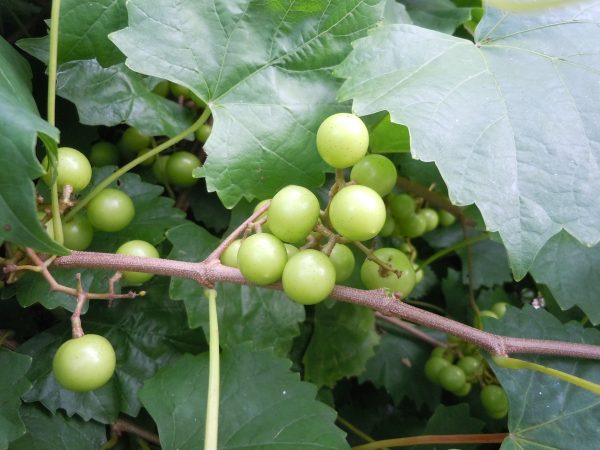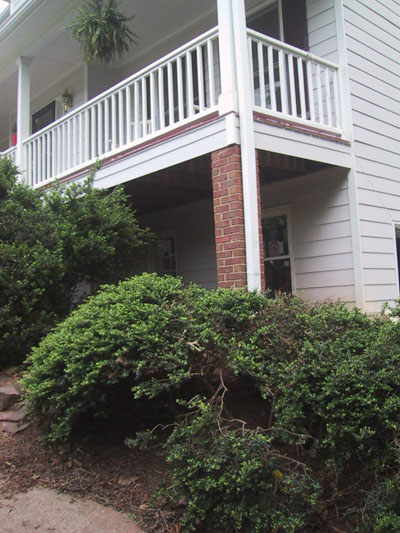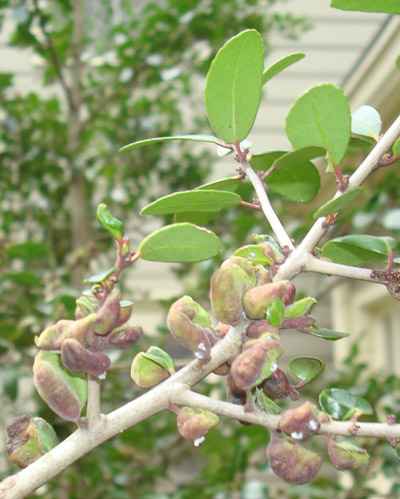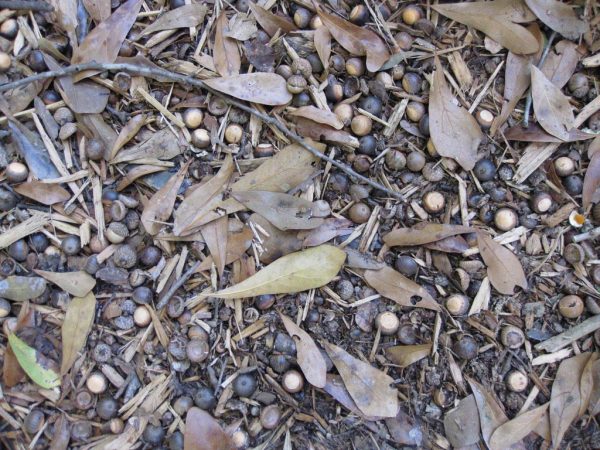Muscadine Grape

Vitis rotundifolia
Muscadines are truly a fruit that puts the South in your mouth. They were discovered here by the early settlers and have been a favorite fruit of Southerners since.
• More detailed information can be found in The Georgia Fruit & Vegetable Book by Walter Reeves and Felder Rushing
• For more information also see the University of Georgia’s muscadine site, Home Garden Muscadines.
Walter’s Mama’s Muscadine Hull Pie recipe
Although Muscadines can be grown successfully in most parts of the South, they are best adapted to Zones 7b and warmer. The severe winters of colder areas hamper production. Muscadines are ideal for backyard gardens because you can successfully grow them with a minimal spray program.
Muscadine varieties can be broken into four categories: two based on fruit color (black or bronze) and two based on flower type: perfect-flowered (self-pollinating) and female. If you plan to grow only one vine, it can be black or bronze, but must be perfect-flowered if you plan to have fruit. Female varieties produce no pollen. Therefore, they must be interplanted with perfect-flowered varieties for proper fruit set.
WHEN TO PLANT
Plant in fall after the first frost or in early spring when the soil is dry enough to work.
WHERE TO PLANT
Muscadines do best when they are in full sun for most of all the day. Muscadines do fairly well on most soil types. Do not plant in a spot where water stands after heavy rains. Muscadines require a minimum 20 feet of trellis per plant. Measure the area where you will plant the vines so you will know how many plants to purchase. If you plan to have more than one row, space the rows12 feet apart. Once you have determined how many plants to buy, lay out the area by putting stakes where the trellis posts will go. The posts will be 20 feet apart. The muscadines should be planted one foot from the post since the fruit load is usually heaviest in the center of the vine.
HOW TO PLANT
Dig a hole large enough to accommodate a bushel basket. Adjust the soil pH to 6.0 to 6.5. If you do not know the pH, take a soil sample (see Resources). If you do not want to take a soil sample, thoroughly mix one-half cup of garden lime (dolomitic type) to the soil taken from the hole. Plant the vine the same depth it grew in the nursery and water it. Following watering, prune the plant to leave about six inches of stem above the soil line. Do not apply fertilizer immediately after planting.
CARE AND MAINTENANCE
A properly trained vine has a trunk, two arms and fruiting spurs. The first two years of training are devoted to developing the permanent trunk and fruiting arms. In the spring following planting, each plant will produce three or four shoots. When these shoots are about one foot long, select the strongest and remove all the others. Tie a string to a small stake. Drive the stake in the ground about three inches from the plant.
Tie the free end of the string to the trellis wire. Train the shoot to the string. Pinch off side shoots as they develop. When the shoot reaches the top wire, pinch it off just below the wire. Let the top two buds form the two arms along the trellis wire.
Since muscadine fruit are borne on new shoots arising from last year’s growth, you should annually prune back the canes that grew the previous year, leaving about three inches of growth to form spurs. Prune in February or early March. Don’t be alarmed if the vines “bleed” at pruning cuts. Bleeding does not harm the vines.
When you leave too many buds on the vine, the plant over produces and the Grapes are poor. After three or four years of production, you will need to remove every other spur cluster to prevent overcrowding. Try to leave spurs that are on the top of the arms.
Remove tendrils that wrap around the arms or spurs. (Tendrils are finger-like plant parts Muscadines use to attach themselves to their supporting structure.) If tendrils are not removed, they will girdle the arms or spurs and cause reduced production.
First year – Apply fertilizer three times: 1) 1/2 pound of 10-10-10 or equivalent after the plants have been settled by rain, 2) two ounces of ammonium nitrate in late May, and 3) two ounces of ammonium nitrate in early July. Broadcast each application over a two-foot circle centered on the plant.
Second year – Timing and method are the same as the first year. Double the rate for each application. Increase the diameter of the broadcast circle to four feet.
Third year – If the vine has grown well the first two years and you expect a crop, apply two pounds of 10-10-10 or equivalent per vine in March. Apply one pound of 10-10-10 per vine in May. Broadcast in a six-foot circle. If plants have not done well, fertilize as instructed for the second year.
Established vines – Apply three to five pounds of 10-10-10 or equivalent per plant in March of each year. Then apply 1/2 pound of ammonium nitrate around June 1.
Grapes have a relatively high requirement for magnesium. Deficiency shows up as yellowing between the veins of older leaves. This yellowing progresses up the shoots as the leaves grow older. To prevent or correct magnesium deficiency, apply Epsom salts at the rate of two to four ounces for one- and two-year-old vines; four to six ounces for older vines. Be sure to evenly broadcast Epsom salts over a three to six foot area.
PESTS
Few diseases or insects affect Muscadines. Japanese beetles may chew leaves in June. Your local Extension office can provide you with a spray schedule for specific pests and diseases.
Fruit – 2020 Homeowner Spray Guide
ADDITIONAL INFORMATION
If you have never eaten a Muscadine, it is a special skill with a delicious outcome! Place a fruit, stem end first, in your mouth and squeeze it between your front teeth. The pulp and sweet juice will pop into your mouth. Discard the skin (if you are in an informal outdoor situation, simply spit it into nearby weeds). Enjoy the juice, then discard the seeds and pulp in the manner described above.
VARIETIES
Variety
Flower Type
Comments
Carlos*
P.F.
Medium size, bronze, productive
Cowart
P.F.
Large size, black, good flavor
Dixie
P.F.
Medium size, bronze, good cold tolerance
Fry*
F.
V. large size, bronze, fruit rot and winter injury a problem; excellent flavor
Higgins
F.
Large size, bronze-pink, mild flavor; late season
Jumbo
F.
V. large size, black, low sugar content
Loomis*
F.
Med-large size, black, excellent flavor
Magnolia
P.F.
Medium size, bronze, good flavor; good winter hardiness
Nesbitt*
P.F.
V. large size, black, good cold tolerance
Noble*
P.F.
Small size, black, productive
Scuppernong
F.
Medium size, bronze, very old variety; low yields
Summit*
F.
Large size, bronze-pink, good winter hardiness; more disease-resistant than Fry
Tara*
P.F.
Large size, bronze, fairly good flavor
Triumph*
P.F.
Med-large size, Bronze-pink, early season
* Most outstanding varieties
2 P.F. = Perfect flowered (produces pollen and fruit) F. = Female flowered (produces fruit only)

















